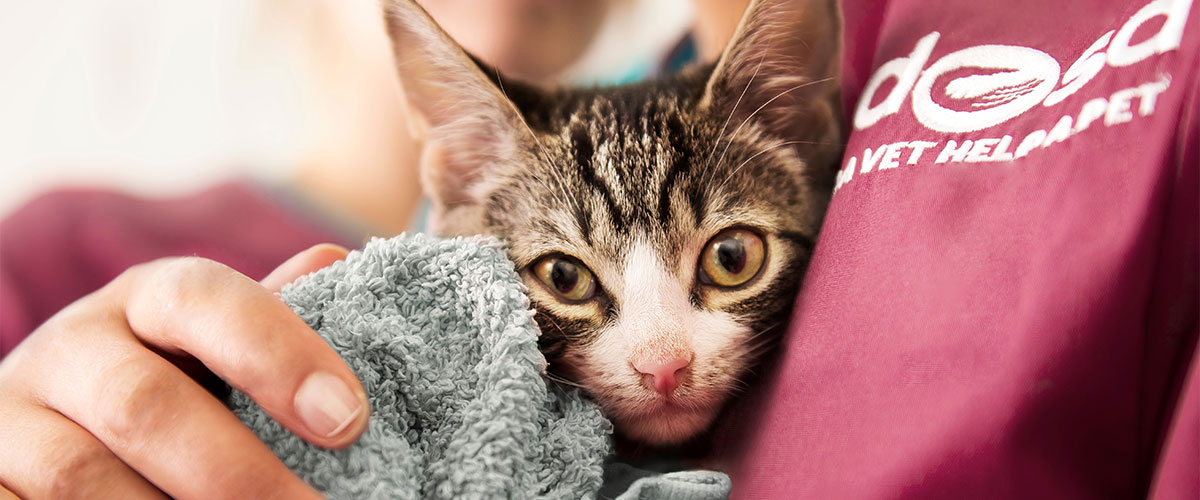CPR for Cats and Kittens

Overview
- CPR (Cardiopulmonary Resuscitation) is a technique that can be used to keep blood and oxygen pumping around the body if the heart stops beating.
- This article tells you how to perform CPR on a cat, but we also recommend that all pet owners learn the technique at a veterinary first aid course.
- CPR is not appropriate for every collapsed cat so it’s vitally important to check whether it’s the right thing to do before starting. It’s also important to be aware that CPR is very often unsuccessful.
- Never perform CPR on a healthy cat, or a cat whose heart is still beating (even if they are unconscious), as it could seriously hurt, or even kill them.
When is CPR appropriate?
CPR is definitely worth a try if an otherwise healthy cat’s heart stops because of a known cause such as electrocution, drowning, or choking. However, if the cat has very severe injuries, or their heart has stopped because of an underlying health problem, trying to bring them back with CPR is very unlikely to be successful, and might not be the kindest option.
Checks before CPR
Before starting CPR, you will need to perform some checks:
Step 1: Are you both safe?
- Make sure that you are in a safe environment and you’re not going to get hurt. Do not start CPR if you are somewhere unsafe.
- Make sure you have someone to help you transport the cat to the vet, if you can’t get to a vet, it’s not a good idea to start CPR.
Step 2: Is the cat responding?
- Call out to check the cat is unconscious, continue speaking as you approach them.
- If they don’t respond, gently rub their side, but be ready to move away quickly in case they turn to bite or scratch – cats are much more likely to be aggressive if they are injured or scared.
- If the cat is unconscious, continue to step 3.
Step 3: Airway
- Pull the cat’s tongue forward to make sure it’s not blocking their airway, and take a look down it to check there is nothing else blocking it.
- If there is something in their throat, remove it following our advice on first aid for choking.
- If their airway is clear, move to step 4 to check their breathing.
Step 4: Breathing
- Is the cat breathing? Look and listen. Can you see their chest rising and falling? Can you feel or hear breath coming from their nostrils?
- If the cat is breathing, they do not need CPR.
- If they’re not breathing, move to step 5 and check for a heartbeat.
Step 5: Circulation
- Place your hand or ear on the left side of the cat’s chest to check for a heartbeat – if you’re not sure exactly where to check, gently pull their front leg back and listen/feel around where the elbow meets the chest.
- If you can’t hear or feel a heartbeat, double check by feeling for a pulse on the inside of their upper thigh.
- If you can’t feel or hear a heartbeat or pulse, begin CPR, and ask someone to call the nearest vet to let them know you’re coming.

- Wrap your strongest hand around their chest with your thumb on top and your fingers underneath.
- Keep your other hand behind their back to stop them sliding backwards when you’re giving CPR.
2. Give 30 chest compressions.

- Squeeze your thumb and fingers together at the rate of two per second (the beat of the song ‘Staying Alive’ is about right)
- Aim to compress the chest by one third to a half, and allow it to return to full size after each compression.
3. Give two breaths.

- Extend the cat’s neck so that their nose is in line with their back, firmly close their mouth and form an airtight seal with your mouth around their nostrils.
- Give them a breath and watch for the rise of the chest. Allow it to fall again before giving a second breath.
4. Repeat 30 compressions followed by 2 breaths for 2 minutes, then check for a heartbeat.

- No heartbeat = continue CPR while continuing to make plans to transport them to a vet. If you have someone with you, swap when your arm arts to get tired – CPR can be very tiring.
- Heartbeat and breathing = take them to the vets immediately as an emergency.
Published: March 2023
Did you find this page useful?
Tell us more
Please note, our vets and nurses are unable to respond to questions via this form. If you are concerned about your pet’s health, please contact your vet directly.
Thank you for your feedback
Want to hear more about PDSA and get pet care tips from our vet experts?
Sign up to our e-newsletter
Written by vets and vet nurses. This advice is for UK pets only. Illustrations by Samantha Elmhurst.

